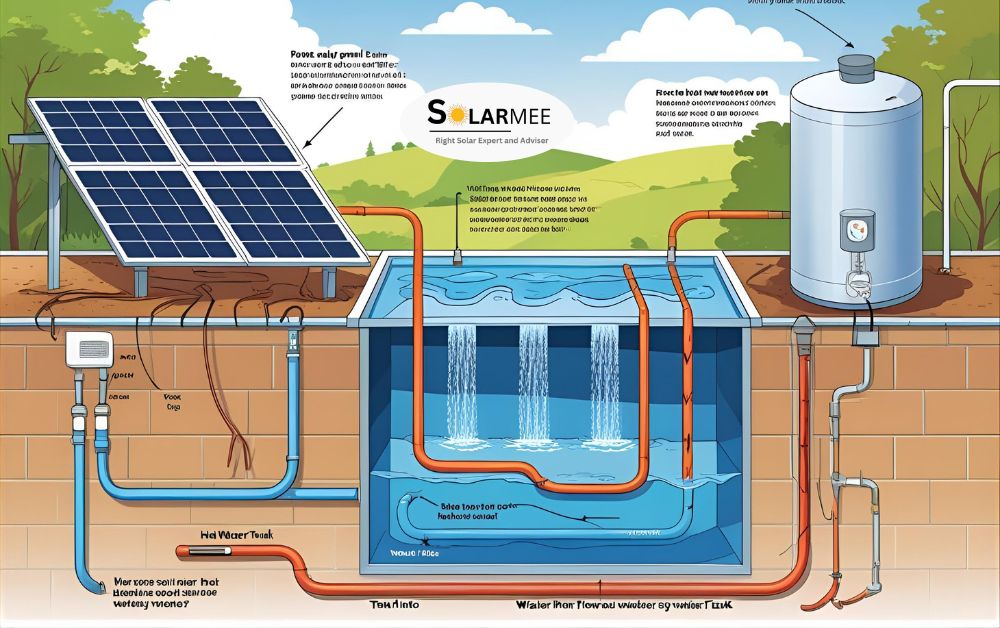Across households in the Australian Capital Territory, solar hot water systems are becoming a more common sight. Not only are they a low-energy substitute to traditional electric or Solar hot water systems ACT, but also because they also fit heating water in the sunny Australian Capital Territory perfectly. The average daily maximum temperature on days when it is uncomfortably hot outside is over 24.4 degrees Celsius.
The system has a considerably superior chance to shine between October and March. Heat units installed in residential settings have a fantastic chance of running efficiently. They can operate either in tandem with or totally separate from plumbing systems that use gas or electricity to heat water. I have occasionally pondered it like this: employing solar hot water is somewhat analogous to using a clothesline rather than a clothes dryer.
You save a few bucks if you go that route, but the savings really pile up when you pay someone to install solar panels in the very sunny space of your roof. Second, using solar hot water is way better for the planet than using electricity, natural gas, or heating oil. The amount of all kinds of harmful gases reduced by solar hot water users is considerable, and its effect is multiplied when you think of the next two points.
The expenses, the advantages, and the operations of these systems will be delineated in this primer, along with a presentation of the best solar hot water choices in the ACT.
What Are Solar Hot Water Systems?
Solar hot water systems are designed to heat water for buildings or residences using solar power. They rely on sunshine far more than just that. Actually, these systems capture a great deal of solar energy, including not only light but also mostly felt but not observed is infrared. The systems are designed so that they are very good at capturing all forms of energy from the sun and then employing it to heat water.
How then does a solar hot water system function? In terms of their look and design, not with respect to their purpose, the panels on the roof are remarkably like the panels on a solar photovoltaic system. These box-like buildings gather sunshine.
The various applications of solar hot water and solar photovoltaic systems distinguish their fundamental divergence. While solar photovoltaic systems are concerned with the generation of electricity from sunlight, solar hot water is mostly about the heating of water. Though they use that resource in very different ways, both of these techniques draw on the same source of plenty of sunlight. One is concerned with the direct construction of electricity; the other is concerned with the direct heating of water.
Solar collectors, the roof panels seizing the sun’s heat, and storage tanks like enormous insulated containers that store Boosters backup heaters running on either gas or electricity, and the hot water; the sun’s failing brightness allows for these devices. Think of a clear-sky thermos loaded with hot tea to help you understand. All heated and ready to use, that tea could be similar to water in a storage tank.
All things considered, the advantage for us results from either less sunlight we pay for or a smaller amount we pay, compensating for alternative sources of energy.
Also Read: Top Solar Panel Manufacturer Companies in Australia

How Do Solar Hot Water Systems Work?
In the ACT, solar hot water systems operate using solar energy, just as other solar systems do. They have components that work in pretty much the same way as the components in a system that uses another kind of renewable energy (like wind). But solar hot water is a special case, and for a few reasons, size and energy yield among them, solar hot water systems deserve their own discussion.
At times, the sun may simply not be sufficient, as on exceptionally cold or overcast days. This is when a boosted (electric or gas) heating system kicks in to bring the water up to the desired temperature. This makes folks ask: Do solar hot water setups need power? Yeah, but only for small works such as moving pumps to change the flow, turning on the extra boost when the sun’s light is low, and for some small tools that don’t really make a significant impact against what we get from the sun.
Because the ACT gets a lot of sun on most days, it’s a perfect place for solar hot water systems that go a long way in cutting our power consumption. We can make a big energy saving through these systems.
Benefits of Solar Hot Water Systems in ACT
You can reap many benefits from employing a solar hot water system in the ACT. The first and most obvious is that you can save a considerable sum of money on your electricity bills. Rather than send all that cash to power companies and pay for the high-cost heating of your water, you can do as generations before you did in the sunny weather of the ACT: let the sun do the work and save you those extra bucks.
Using solar power is very good for the environment. It does not generate hazardous gases. By using solar energy, you lower your carbon footprint and help preserve the purity of the air.
One more big upside of the ACT is that the government is right behind solar power. There are rebates and incentives available that make it much cheaper to buy and install an outright solar hot water system. This makes for a very fast payback on your investment.
In conclusion, owning a solar system makes your home more energy independent. You aren’t dependent on utility companies. You aren’t dependent on anyone or anything. And you aren’t going to be. Saving money. Helping the planet. Getting government support. Enjoying energy independence. It’s all in a day’s work for a solar homeowner.

Solar Hot Water Systems in ACT (Australian Capital Territory) Cost
Solar water heating installation expenses in the Australian Capital Territory (ACT) mainly hinge on the capacity and kind of system. In general, buying the system alone is likely to set you back anywhere between $3000 and $7000. Installation will usually add another $1,000 to $2,000. Once the system’s in, maintenance is pretty much a no-show; you just have to remember to call the techs for their every-few-years visit.
When it comes to installing solar hot water systems, those with electric boosters are generally the cheaper option. Manufacturers can use cheaper parts and simpler designs when they make these products, and that is why these products are cheaper to make. Unfortunately, if we take electric-boosted systems as an example, these systems are likely to use more electricity, and so their running costs will not be low. On the other hand, gas-boosted systems require a higher installation cost, but as a result, you will save some money, as they consume less energy for the same task.
The first impression of the initial investment being quite high is totally negated by the long return on investment. Families can net savings in the ballpark of hundreds of dollars yearly on energy expenses. Over a span of 5 to 10 years, these net savings nearly always add up to cover the original cost of the system, after which time it continues to pay for itself and reduce net household expenses even further.
Best Solar Hot Water Systems in ACT (Guide & Review)
- If you live in the ACT (Australian Capital Territory), solar hot water is an excellent alternative that will help you save a lot of money on your electricity bills. As a rule, the most efficient solar hot water systems in the ACT (Australian Capital Territory) are generally divided into two main categories: flat plate collectors and evacuated tube systems.
- Flat plate collectors are quite easy, reliable, and do not cost much. They provide good results in a lot of sun, but in a very cold environment, their efficiency can be a bit lower. Whereas evacuated tube systems are more sophisticated. They take heat even if the sky is covered or the weather is frosty, which is why they are perfect for Canberra’s cold winters; however, their installation can be more expensive.
- Rinnai, Apricus, and Rheem are some of the most trusted names in the ACT brand range. Rinnai is at the forefront of durable systems, Apricus is setting the trend for energy-efficient systems, while Rheem is offering a wide range of models to suit different budget plans.
Therefore, if you are looking for less money to be paid at the beginning of the project, a flat plate system might do the trick. But in case you want a very powerful performance throughout the year, the evacuated tubes are most likely to be the right option. The right decision about the system is based on how much money you have, the size of your house, and your family’s hot water consumption.
Tips for Choosing the Right Solar Hot Water System in ACT
The first aspect you should look at when getting a solar water heater system for your home in the ACT is the number of people in your family. A bigger family would take a bigger system in which to comfortably satisfy their needs, but two to three people can still be okay with the same solar system. Also, think about your roof. If it’s wide and well-lit with sun, solar panels can go there. In addition, if your household is living off-grid, think about the advantages that you could gain by using a solar hot water system.
The budget is also significant. Even though solar systems can be more expensive at the outset, they usually save customers a considerable amount of money long term because people pay much less for electricity once a solar system is installed. Always have a professional solar system installer do the work. This ensures much better performance, much more of the time than if the customer themselves were to install the system. And after the work is done, if the customer has a problem with the system, the after-sales service that the installer provides could be very important.
Also Read: Solar Hot Water Systems Tasmania
Conclusion
Selecting solar hot water systems for your house in the ACT is a wise and ecologically friendly choice. In addition to reducing costs, they offer an energy-efficient substitute for traditional water heaters. They accomplish this by harnessing the power of the sun, converting its energy into heat capable of raising water from ambient to almost boiling temperatures. Solar water heaters operate very effectively year-round as the sun is rather steady and strong, even during the usual winter day. And they do it free from emissions.

“Hi, I’m Ishita ,a content writer who loves turning ideas into engaging stories. I specialize in writing blogs, articles, and website content that connects with readers. Over the past few years, I’ve worked with startups and companies to create clear, creative, and impactful content. When I’m not writing, you’ll usually find me reading or exploring new ideas for my research. This website is my space to share my work and connect with people who value quality writing.”




